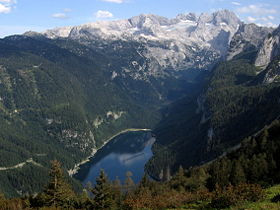Dachstein
| Hoher Dachstein | |
|---|---|

Hoher Dachstein from the north-west, with the Vorderer Gosausee in the foreground
|
|
| Highest point | |
| Elevation | 2,995 m (9,826 ft) |
| Prominence | 2,136 m (7,008 ft) Ranked 8th in the Alps |
| Listing | Ultra |
| Coordinates | 47°28′31″N 13°36′23″E / 47.47528°N 13.60639°ECoordinates: 47°28′31″N 13°36′23″E / 47.47528°N 13.60639°E |
| Naming | |
| Translation | high roof stone (German) |
| Pronunciation | German: [ˌhoː.ɐˈdaxʃtaɪn] |
| Geography | |
| Location | Upper Austria / Styria, Austria |
| Parent range | Northern Limestone Alps |
| Geology | |
| Age of rock | Triassic |
| Mountain type | Limestone |
| Climbing | |
| First ascent | 1832 Peter Gappmayr (Gosau side) |
| Hallstatt-Dachstein Salzkammergut Cultural Landscape | |
|---|---|
| Name as inscribed on the World Heritage List | |
 |
|
| Location | Austria |
| Type | Cultural |
| Criteria | iii, iv |
| Reference | 806 |
| UNESCO region | Europe and North America |
| Inscription history | |
| Inscription | 1997 (21st Session) |
Hoher Dachstein is a strongly karstic Austrian mountain, and the second highest mountain in the Northern Limestone Alps. It is situated at the border of Upper Austria and Styria in central Austria, and is the highest point in each of those states. Parts of the massif also lie in the state of Salzburg, leading to the mountain being referred to as the Drei-Länder-Berg ("three-state mountain"). The Dachstein massif covers an area of around 20×30 km with dozens of peaks above 2,500 m, the highest of which are in the southern and south-western areas. Seen from the north, the Dachstein massif is dominated by the glaciers with the rocky summits rising beyond them. By contrast, to the south, the mountain drops almost vertically to the valley floor.
The geology of the Dachstein massif is dominated by the so-called Dachstein-Kalk ("Dachstein limestone"), dating from Triassic times. In common with other karstic areas, the Dachstein is permeated by a rich cave system, including some of the largest caves in Austria, such as the Mammuthhöhle and the Hirlatzhöhle. Another significant tourist destination is the Eisriesenhöhle. The Dachstein is famous for its fossils, including Megalodonts; the Linzer Weg leads over many such fossils, which are referred to as Kuhtritte ("cattle footprints").
Glaciers are uncommon in the Northern Limestone Alps, and those on the Dachstein — the Hallstätter Gletscher ("Hallstatt glacier"), the Großer Gosaugletscher ("great Gosau glacier") and the Schladminger Gletscher ("Schladming glacier") — are the largest, as well as being the northernmost and the easternmost in the whole of the Alps. Several smaller ice-fields also exist, such as the Kleine Gosaugletscher ("lesser Gosau glacier") and the Schneelochgletscher ("snow-hole glacier"). The glaciers are retreating rapidly, and may disappear entirely within 80 years. The Hallstatt glacier withdrew by 20 m in the year 2003 alone.
...
Wikipedia

